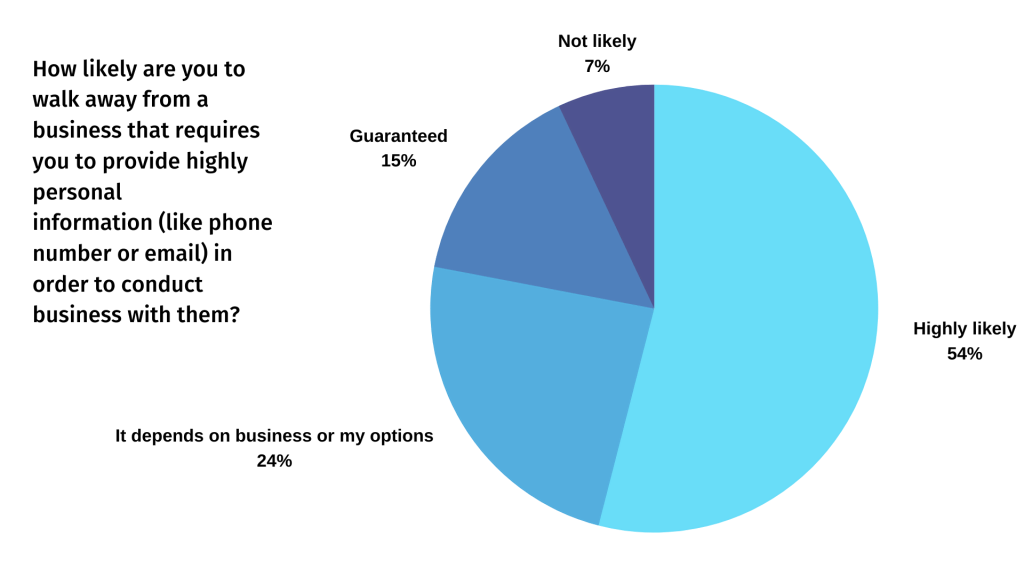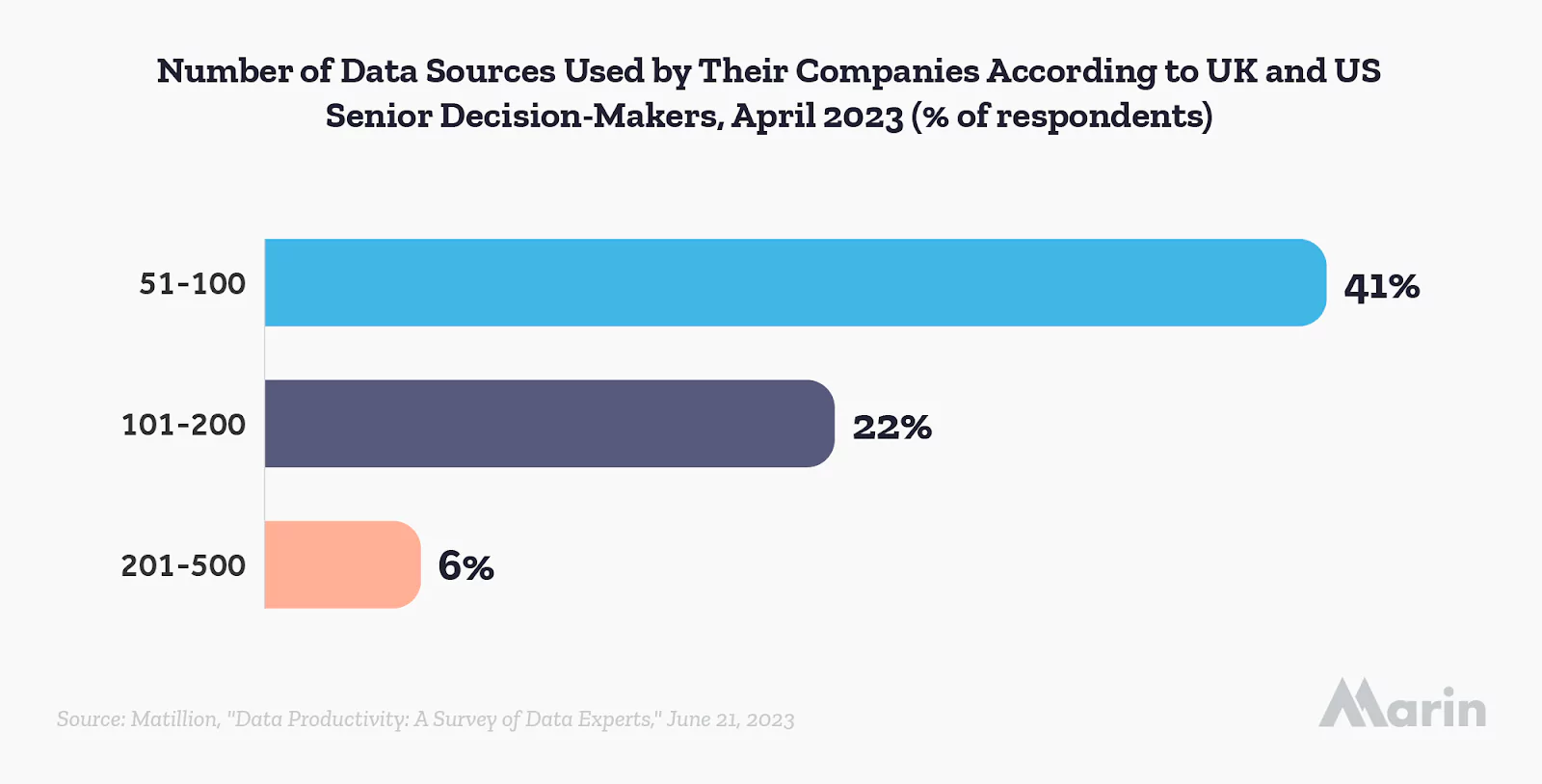
Some businesses will always find ways to implement new technology trends, while others lag behind. For example, some companies immediately recognized the internet’s potential and built websites in the ’90s, while other businesses still operated without an online presence.
Data analytics is a field that’s been rapidly expanding, and that growth is predicted to continue over the next decade. Like the internet, your business can operate without data analytics tools, but there are a lot of benefits that putting data into action can provide you with. There's an expectation that by 2026, 65% of companies will primarily be data-driven to achieve optimal performance and personalization.
In 2024, we can expect the gradual removal of tracking cookies. Cookies have been crucial for marketing efforts over the past decade. Data analytics is one of the solutions to maintain your marketing campaigns in the ‘cookieless world.’
This article will help you understand the direction in which data processing is going and the relevant technologies accompanying it.
Evolution of Data Analytics
Although there were concepts that we can argue were predecessors to data analytics before this, what experts consider the beginning of data analytics was the rise of spreadsheets.
The so-called 'spreadsheet era' started at the end of the 20th century and was defined by Microsoft Excel.
Can you imagine your life without using several spreadsheets to organize your personal and professional life? Spreadsheets are still fantastic for budgeting, making charts, analyzing statistics, and many other reporting tasks.

However, as valuable as spreadsheets are, they are significantly lacking when it comes to handling large volumes of data. This pain point has led to the rise of business intelligence, a type of technology that allows companies to convert raw data into meaningful information, helping decision-makers and marketers.
As the internet grew, the requirements for adequate handling and analyzing of data followed. Soon, we entered the era of big data, characterized by volume, velocity, and variety.

Key Technologies Powering Data Analysis
At the top of importance for data analytics, we can undoubtedly find artificial intelligence (AI) and machine learning (ML). During data gathering, companies often end up with batches of data that are difficult to decipher.
To convert this data into something meaningful and helpful, AI and ML can streamline the process that would otherwise take lots of time. AI and ML are excellent at uncovering patterns and predicting and automating complex tasks.

AI is far from taking over the world like many people preach, but its capabilities are exceptional. Its applications range from writing articles, creating mockups for websites, and generating logos, to analyzing millions of data points.
Another concept that streamlines data analysis is edge computing. This type of technology processes data close to where it's being generated so results can be seen in real time. For example, traffic management systems use edge computing to analyze the amount of traffic on different roads, and immediately process that data so the system can adjust the timing of stoplights.
The advantages that edge computing brings are enhanced real-time analytics and optimized bandwidth usage. Because of these benefits, edge computing is everywhere, from the Internet of Things to corporations that handle vast amounts of data.

Data is often collected anonymously and falls under the strong protection of regulations such as the General Data Protection Regulation (GDPR) and the California Consumer Privacy Act (CCPA).
Since security is important in this field, many experts have switched to blockchain technology.
Why? The incredible potential of blockchain technology lies in its ability to offer a decentralized digital ledger that allows for secure and transparent transactions.

By removing the need for a central authority to manage data, we can significantly reduce the risk of data breaches and unauthorized access.
With blockchain’s advanced encryption methods, only authorized parties can access data, enhancing confidentiality and security.
We’re excited about the endless possibilities of blockchain technology, and we can’t wait to see how it’ll revolutionize the way we do business and interact with each other.
Storing Big Data in the Cloud
Data analytics requires vast amounts of storage. Since many businesses don’t have the resources or personnel to manage their own servers and storage, cloud platforms are key.
Why? Cloud storage is scalable and allows businesses to continually invest in larger plans as they continue to grow.
Amazon Web Services (AWS), Microsoft Azure, and Google Cloud Platform (GCP) provide scalable and flexible storage solutions. The Cloud Storage Market is expected to experience a compound annual growth rate (CAGR) of 24% and reach a market value of $376.37 billion by 2029.

The downside of cloud storage is that it can be vulnerable to security threats.
However, in addition to the blockchain use cases mentioned above, other strong cybersecurity precautions like antivirus protection and password managers can go a long way toward keeping your sensitive data safe. You should also have an AWS backup plan to maintain data resilience in the event of a data loss or system failure.
Not to mention, large servers negatively impact the environment as they consume a lot of power. So, prioritizing data center sustainability can go a long way if you’re a corporation using vast cloud resources.
Opting for eco-friendly and sustainable options is more ethical and responsible. Moreover, with regulatory frameworks like California’s Title 24 and The United States’ SEC Climate Risk Disclosures, you can be confident that your organization is not only contributing to a better planet but also adhering to evolving regulations.
Contrary to popular belief, big data isn’t only present in large corporations. Small and medium-sized businesses can also handle big data and have access to various cloud-based tools to do so.
Reverse ETL
Conventional ETL methods have traditionally ruled the big data landscape, but we can expect innovations this year. The emergence of reverse ETL will allow businesses to use real-time personalization and make better data-driven decisions.
Traditional ETL (extract, transform, load) extracts data from external sources, transforms it, and loads it into a data warehouse. It allows you to store your data in a single data warehouse.
Reverse ETL is the opposite. It takes the data from your data warehouse and delivers it to third-party APIs. Think of it like a pipeline connecting the valuable info in your data warehouse to the rest of your organization.
One of the most relevant use cases for Reverse ETL is the marketing industry. It allows marketers to segment their audience with precision - retargeting some while suppressing others and creating lookalike audiences as well.

Data Privacy and Ethical Considerations
Data analysis often intertwines with various ethical concerns.
For example, regulations such as the GDPR were adopted because corporations had unfair advantages and were intruding on the privacy of individuals.
In the past, third-party cookies were utilized so that individuals could be tracked and their personal information used for better ad targeting and marketing. But GDPR has tightened the reins on collecting that data. Likewise, HIPAA compliance is now mandatory for healthcare organizations to keep patient data safe and private.

Regardless of the size of your company, it’s important that you’re operating transparently and that users are aware of what types of data you’re collecting and for what uses. Gathering data without user consent is illegal in many regions, depending on local internet privacy regulations.
Furthermore, transparent and responsible data practices will lead to a much better reputation with your customers or users.
Industry-Specific Applications
Various industries benefit from data analytics. For example, digital marketing programs that leverage historical data to drive future results can improve campaigns tenfold. With the help of a marketing automation platform like Marin, Marketers can turn data points like sales, clicks, and impressions into actionable insights.

In the healthcare industry, data analytics can help predict the progression of certain diseases. By analyzing a patient’s history, doctors can recognize certain trends and provide better care and medicine.
Hospitals also require a lot of resources. Data analytics can help provide better resource allocation, ensuring a more streamlined system that will benefit both the personnel and the patients.
Finance, an industry mainly consisting of numbers and statistics, welcomes data analytics with open arms. Why? AI and ML are amazing at working with numbers. Transactional data and user behavior are data inputs that can take their service offerings to the next level.
Data analysis systems can help businesses understand the normal behavior of their users and then notice fraudulent activity. Fraud detection has been vastly improved with AI and ML.
Authenticating Data
41% of senior decision-makers agree that their organizations use between 51–100 data sources.

Of course, an essential part of data analysis is that data comes from trustworthy sources.
As the saying goes, garbage in, garbage out. If most of your users turn out to be automated bots, then using their data for any decisions would be meaningless.
Security protocols such as OpenID Connect (OIDC) can help you authenticate users and ensure that you gather genuine information. Generally, finding usable and accurate data is one of the biggest challenges of converting data into action. Besides, if you have limited information, AI and ML analysis can be biased.
Although data analytics isn’t an entirely new field, the tools that are currently in use and that are emerging haven’t stood the test of time. Many data experts haven’t spent enough time polishing their craft using the latest tools.
Data Pipelines for Marketers
Need inspiration on what tools are a must-add to your tech stack? Look no further than a marketing data pipeline solution.
Leveraging a marketing data pipeline is essential to get the most out of your marketing data. Why? The right platform guarantees you have accurate and timely insights to:
- Improve your overall marketing strategies
- Optimize your marketing campaigns

Marin Connect is a comprehensive MDP platform for all your data needs — including collection, preparation, storage, analysis, reporting, and forecasting. One platform. No fuss, no muss.
With Marin, you can expand into additional capabilities, including:
- Automated budget management
- Dynamic spend allocation
- Campaign automation
- Optimization
In short, it’s a one-stop shop that does all the heavy lifting for your paid media campaigns. Schedule a demo with a Marin expert to learn more.
Key Takeaways
Data science is truly incredible. With its numerous benefits and diverse applications, it’s easy to see why one might think it’s magical. While we don’t want to oversell its capabilities, rest assured that data science can definitely give your company a boost without causing chaos.
To effectively apply data analytics, you need expert personnel, adequate tools, and a lot of patience. Analyzing data and effectively making predictions can take time.
Data has the power to improve a successful business but can’t make a failing business a success. Analyzing data won’t compensate for a poor product, service, or market. However, it can be vital if you’re looking to get ahead of your competition.
Don’t jump on every new emerging trend. Lean back and observe how specific fields are progressing. Take effective actions based on how you hope to use data to transform your business in the long run.
Here’s to your success!



